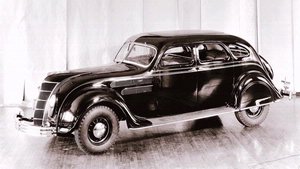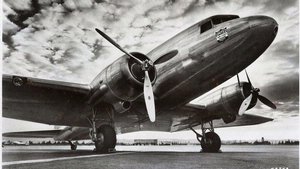The Airplane and Streamlined Design
Aerodynamic streamlining made aircraft fly more efficiently and transformed aircraft design in the late 1920s and the 1930s. Streamlining is evident in the drag-reducing engine cowling and wheel pants of Earhart’s Lockheed Vega, and it culminated in the sleekly modern Douglas DC-3.
The dynamic look of streamlined aircraft captured the imagination of industrial designers, who translated that look into a new design expression. They borrowed motifs from the airplane’s curvilinear appearance and incorporated them into railroad locomotives, automobiles, architecture, appliances, and household objects.
Streamlined design was characterized by horizontality, speed lines to denote motion, and a lack of ornamentation. In industrial design and architecture, it often used such materials as Vitriolite, Bakelite, glass block, chrome, and stainless steel. Streamlined moderne, as the style became known, was a cultural symbol of the Depression era.














